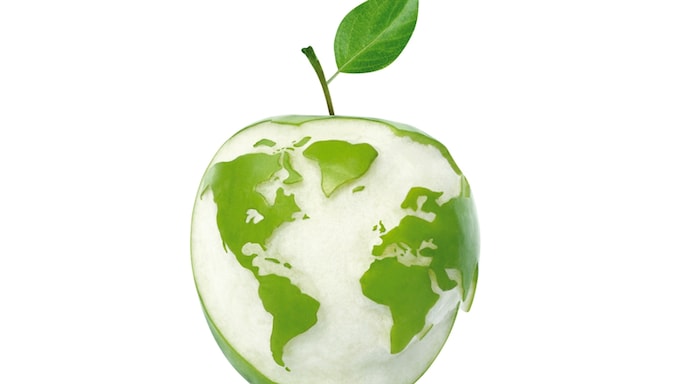- HOME
- /
- Better Living
- /
- Planet
- /
Eat Better for the Planet
You’re environmentally conscious—and hungry. Here are answers to all your eco-friendly food questions
 Wolfgang Kraus/Dreamstime.com
Wolfgang Kraus/Dreamstime.com
Does what I eat have an effect on climate change?
Yes. The world’s food system is responsible for about one quarter of the planet-warming greenhouse gases that humans generate each year. That includes raising and harvesting all the plants, animals and animal products we eat, as well as processing, packaging and shipping food to markets all over the world.
How exactly does food contribute to global warming?
When forests are cleared to make room for farms and livestock, large stores of carbon are released into the atmosphere, which heats up the planet. Also, fossil fuels are used to operate farm machinery, make fertilizer and ship food around the globe, all of which generate emissions.
Which foods have the largest impact?
In general, beef and lamb have the biggest climate footprint per gram of protein—livestock accounts for roughly the same amount of emissions as all the cars, trucks, airplanes and ships in the world today—while plant-based foods like beans, pulses, grains and soy tend to have the smallest effect. Pork, chicken, eggs and mollusks such as clams, oysters and scallops are somewhere in the middle.
These are only averages. Beef raised in the United States produces generally fewer emissions than beef raised in Brazil or Argentina. And certain cheeses can have a larger greenhouse gas impact than a lamb chop.
Is there a simple food choice I can make that would reduce my climate footprint?
Consuming less red meat and dairy will typically have the biggest effect for most people in wealthy countries. A number of studies have concluded that people who eat a meat-heavy diet could shrink their food-related footprint by one-third or more by moving to a vegetarian diet. Giving up dairy would reduce those emissions even further. If you don’t want to go that far, just eating less meat and dairy can reduce emissions.
Why does meat have such a big effect on the climate?
It’s often more efficient to grow crops for humans to eat than it is to grow crops for animals to eat and then turn those animals into food for humans. A 2017 study by the United Nations Food and Agriculture Organization concluded that, on average, it takes about 1.3 kg of grain to raise 500 gm of meat.
Beef and lamb have an especially large climate footprint for another reason: The stomachs of cows and sheep contain bacteria that help them digest grass and other foods. But those bacteria create methane that is then released through burps (and flatulence).
What about chicken?
A number of studies have found that poultry has a lesser climate impact than other livestock. Modern-day chickens are bred to be extremely efficient at converting feed into meat, though this has prompted major concerns about animal welfare.
Should we just stop eating meat?
Not necessarily. A number of experts have argued that a sustainable food system can and should include plenty of animals. Cows and other livestock can be raised on pasture that would otherwise be unsuitable for growing crops, and they eat crop residues that would otherwise go to waste. They produce manure that we can use as fertilizer. And animal agriculture provides livelihoods for some 1.3 billion people worldwide.
How else can meat become more climate-friendly?
Advances in animal breeding, veterinary care, feed quality and grazing systems are helping to shrink the climate footprint of livestock operations. The United States, for example, produces more beef today than it did in 1975, even though the total number of cattle has declined by about one third.
What about ‘fake meat’?
Plant-based meat substitutes made from vegetables, starches, oils and synthesized proteins attempt to mimic the taste and texture of meat. While the jury is out on whether these products are healthier, they do likely have the smaller environmental footprint they promise: One study estimated that a Beyond Burger [a plant-based faux meat] had just one-tenth the climate impact of a beef burger.

What kinds of seafood should I eat?
Wild fish often have a relatively small climate footprint, with the main source of emissions being the fuel burned by fishing boats. One recent analysis found that a number of popular wild fish—anchovies, sardines, herring, pollock, cod, haddock—have, on average, a lower carbon footprint than chicken or pork.
There is a huge caveat to all wild seafood, though: Most fisheries are being fished at their maximum sustainable level, while others are being overexploited. So there’s not a lot of room for everyone in the world to increase wild fish consumption.
How much impact do milk and cheese have on climate change?
Milk typically has a smaller climate footprint than chicken, eggs or pork per kilo. Yoghurt, cottage cheese and cream cheese are similar to milk. But cheddar and other hard cheeses can have a significantly bigger footprint than chicken or pork, since it typically takes about 4.3 kg of milk to make 500 gm of cheese. A vegan diet (no meat, dairy or eggs) has the smallest climate footprint.
If I can’t go completely vegan, what else can I try?
You could go vegetarian: no meat, poultry or fish, but you can eat dairy and eggs. Food manufacturers and restaurants are used to accommodating vegetarians. Another option is to try cutting back to one serving of red meat per week, replacing the rest with chicken, pork, fish or plant proteins.
Is organic produce better for the climate?
Organic produce is grown without synthetic fertilizers or pesticides, but that doesn’t mean it’s necessarily better than conventionally grown produce from a climate perspective. In some cases it can be worse—organic farms often require more land.
Should I buy only produce that is local and seasonal?
In general, what you eat matters a lot more than where it comes from, since transportation accounts for only about six per cent of food’s total climate footprint. That said, some perishable fruits and vegetables shipped by plane can have a hefty carbon footprint. By contrast, apples, oranges and bananas are often shipped by sea, which is more fuel efficient. Cold-climate vegetables such as carrots, potatoes and squash can be stored after the fall harvest and last through the winter.
Can I really make a difference?
It’s true that one person alone can make only a tiny dent in the global climate problem. On the other hand, if many people made changes to their diets, that could start to add up. As the world’s population keeps growing, farmers and ranchers will need to curb their emissions and grow more food on less land to limit deforestation. Experts have argued that it would make a big difference if the world’s heaviest meat eaters scaled back—even moderately.
Adapted from the New York Times (30 April 2019), Copyright © 2019 by the New York Times, NYTimes.com.






